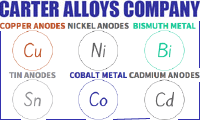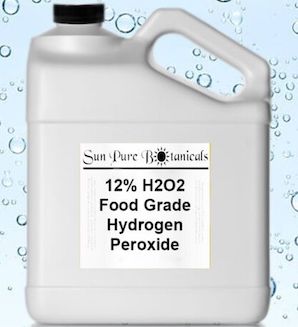
Home of the world famous 'finishing.com HOTLINE' since 1989
-----
Carbon treatment of copper plating bath
adv.: Supplier of Copper Anodes, Nickel Anodes, Bismuth Metal, & Other Metal Products for Industry & The Arts

December 4, 2021
Q. Hi there I'm using a basic watts acid copper bath in a 40 gallon tank with continuous filtration.
H2O2 (hydrogen peroxide) is recommended for pretreatment before carbon filtering.
I'm wondering if I could use the dry form of sodium percarbonate instead. It's widely available for home brewing - and has some added chelating agents that might be useful otherwise for breaking up contaminants . Would it work?
Buying cases of small bottles of hydrogen peroxide is getting old and seems stupid. I can't get more concentrated versions over the mail.
Lmk?
Thanks!
Raphael
- Brooklyn, New York
A. Hi Raphael. The beauty of hydrogen peroxide is that it decomposes to oxygen bubbles and water. I am not familiar with the use of sodium percarbonate (Na2H3CO6) which decomposes to washing soda ⇦ on eBay or Amazon [affil link] (Na2CO3), which obviously will build up. I would suggest testing it in a Hull Cell ⇦ huh? before possibly damaging your 40-gallon tank.
But I don't think you are limited to little bottles of 3% H2O2; I see gallon jugs of 12% H2O2 on Amazon, and 30% from other sources.
Luck & Regards,

Ted Mooney, P.E. RET
Striving to live Aloha
finishing.com - Pine Beach, New Jersey
Ted is available for instant help
or longer-term assistance.
December 2021
⇩ Related postings, oldest first ⇩
Q. I have a copper bath which is contaminated and I want to treat it with carbon treatment but I am not sure if the carbon filter will affect my copper bath.
I have never used carbon treatment for copper bath.
Is there any other way to do it ?
Thank you in advance,
Student - Minneapolis
August 2, 2008
? What type of copper bath is it? Acidic? Alkaline? Alkaline cyanide? Pyrophosphate? This information is important to know as is the difference between carbon filtration and carbon treatment. Which is the one you intend to do? What is the approximate solution volume (the suggestions may be different depending upon volume), what type of filtration do you have available?
Information is always necessary to give an informed opinion (and yes that is what you will get from people on this site, opinions since there is more than one theory on how to do just about everything).
- Great Neck, New York
August 6, 2008
January 19, 2012
Q. Hi, I have a 150 Gallon Copper Pyrophosphate Electroplating Bath that I use for small quantities of private Blank Copper Masters (14" Discs). I have run into problems in the past that I was not able to fix by adjusting the chemistry of the bath (which I do in house, plus have checked periodically by an outside lab) and the only two options I am left with are:
a) Carbon Treatment;
b) Partial (or full) dump and remake of the solution
The bath I have is new (made in the last 8 weeks). I have 8,000 amp hours on both cells (I run 2 cells, that are separate, but pull from the same sump below). I've plated around 177 plates (both useable and unusable plates).
The way I have carbon treated in the bath is:
a) Remove existing filters;
b) add Activated Carbon Filters (10 micron, 30 inch) to my bath, allow it to sit for 5 - 7 hours;
c) Pull the Carbon Filters out, add new regular filters and allow it to sit for 5 - 7 hours;
d) Run several loads of parts (at least 6 to 8).
Sometimes I am back up and running after the 8th load, sometimes it takes much longer.
I cannot find something specific on this and would really like to know if the way I have it is right, or if there is another way to do it.
When I do (d) above (Run several loads of parts "Dummy Plates"), I generally run them at 40 amps (which is my operating amperage - 40 amps for 2.5 hours), and the voltage is around 1.95 - 2.0 (During the dummy plating, when not dummy plating my voltage is generally between 1.98 - 2.35).
Any assistance or direction that can be given for this, would be greatly appreciated.
Thank you very much.
Plate Shop Manager - Camarillo, California
A. Dante,
Your applied voltage for plating the discs and dummying voltage are almost the same.So, what you are probably doing is your plating is dummying.
You have not mentioned what current density you are applying for plating the discs.
Increasing the CD to 30-40 ASF should help overcome your difficulty.
- Mumbai, Maha. India
January 24, 2012
A. It sounds like the difference in current density between your regular plating and dummying is too low. Either you need to dummy at lower CD, or plate at higher CD. This will allow the dummying to more effectively remove the impurities that you don't want in your plated product, and also prevent them from appearing in your plating when present in low concentrations.
John Reid- Brisbane, Queensland, Australia
January 26, 2012
January 29, 2012
Q. Hi, thank you for your replies.
My part is round 14" stainless steel (about the same thickness of a vinyl record.
I plate for 40 amps at 2 hours, 30 minutes.
Our sump tank inside dimensions is 84" long x 20.5" wide x 19.5" height. I like to have 6 - 8 inches of space from the top of the fluid to the top of my tank (so we run about 11.5 - 13.5 inches of fluid in the bath or a total of 116 - 132 gallons of plating solution (we have 2 cells that pull from the same sump, each cell is 16 gallons).
We have a large sump tank at the bottom, a filter chamber that holds three (3) thirty (30) inch polyserf pleated 10 micron filters. All the solution is filtered from the sump before it goes to the cells above.
We use titanium baskets (without bags) and have been using Luvata 14 mm x 12 mm mini copper phosphorous slugs. We were using Oxygen-Free High Conductivity, but those did not give us a good result and we used the Luvata ones before when we were plating good copper.
We have air agitation for both cells and good flow.
- Camarillo, California, USA
A. Hi Dante,
I'm wondering whether you really have a problem with organic contamination or whether the carbon treatment and subsequent plating is correcting a solution imbalance especially brightener/ammonia.
Let's consider organic contamination which will respond to carbon treatment - not all organics will. Once the bath is sufficiently contaminated to cause serious plating problems, simple filtration through carbon may be very slow. A better procedure, from the point of view of effectiveness, is a batch carbon treatment. This is very messy and avoided if possible. If you wish, I will detail the process. If you get regular organic contamination, then I have 2 recommendations.
1) Look for and eliminate the source. Suggestions if needed.
2) Use continuous filtration. In an earlier posting you said that you were using PY61 as a brightener: this will not be lost on carbon.
As I said at the beginning, I suspect that the answer lies in bath balance. In particular, brightener and ammonia
⇦ on
eBay or
Amazon [affil link] but also pH and P2O7:Cu ratio. Will you describe the nature of the defect that causes that plating failures and also your routine for making additions to the bath?
Harry

Harry Parkes
- Birmingham, UK
January 21, 2012
-- out of chronological order / editor accidentally delayed the posting of this entry
Q. Hi, I work with Dante but he's not here right now. You asked about the bath additions used. We use 400 ml py61h and 150 ml ammonium hydroxide per load.
We run approx. 3 loads per day and 3 loads on the night shift. Each load runs for 2 and a half hours.
I'm interested in your comments regarding a possible imbalance, could you elaborate?
Ben
- Los Angeles, California
February 26, 2012
A. Hi Ben,
I'll gladly try to expand on my thinking. But first, would you confirm information that I have extracted form your submissions.
1) a load consists of one 14" disk plated at 40 amps for 2 hours, 30 minutes
2) you add 400 ml PT61H and 150 ml ammonia per load - what is the strength of the ammonia?
At no time has the fault which causes you so much trouble been described. Will you have a go please?
Harry

Harry Parkes
- Birmingham, UK
February 29, 2012
Q. Hi Harry,
Thanks for your reply.
The information you laid out is all correct. The ammonium hydroxide percentage is 29%
The nature of the defect is tiny pitting. This is small and were it only a cosmetic issue this would not even be a concern as you have to hold the discs up in the light to even see them. However, they make noise when played as a record. They play as tiny little pops or ticks and this is non optimum and is what we are trying to resolve.
Ben
- Los Angeles, California
February 29, 2012
A. Hi Ben,
Thanks for the information on the defect. It has changed my line of thought. I was thinking build up of brightener causing "step plating" - small areas of no plating where too much brightener is absorbed and inhibits plating. Or maybe, the opposite - insufficient brightener.
Is it possible that these very small "pits" are in fact just the opposite and are tiny inclusions or lumps? Unsuitable anodes, such as phosphorized copper, can cause very fine roughness. Because anodes should not be bagged it is very difficult to deal with. My own strong recommendation would be for OFHC copper anodes. I note that Dante says that you did not get good results with OFHC but with no information as to what was wrong. My immediate thoughts are:
1) consider returning to OFHC anode - even with these an occasional batch has been known to have tiny particles breaking away and cause roughness.
2) at least make sure that the present anodes are clean and pink looking with no brown sludge or greenish slime (precipitated brightener).
3) If you really do have tiny holes, it is possible that you have inclusions of tiny particles which are washed away during rinsing.

Harry Parkes
- Birmingham, UK
March 3, 2012
Q. Harry,
I have a question about a full powered carbon treatment. How long is it safe to settle out the powered carbon after the treatment before earth pack filtering it out?
There seems to be very little data on how long is too long before some organics are released back out of the carbon and into the treated bath again.
Thank you,
Jeff
- Niagara Falls, New York. USA
January 11, 2016
|
|
A. Hi Jeff,  Harry Parkes - Birmingham, UK February 3, 2016 February 2, 2016 A. Good day Jeff. Aerotek Mfg. Ltd. - Whitby, Ontario, Canada |
![]() Thank you both Harry & Eric for your replies.
Thank you both Harry & Eric for your replies.
We keep a stock of treated copper in drums for a quick bath swap to reduce line downtime. We do the peroxide and powered carbon treatment on all our used copper solutions so anytime we need a copper bath we are starting with a fresh bath.
I recall there was a study done long ago with bath TOC's compared to the time the bath sat after treatment with the carbon left in it before filtering it out. I was just trying to update our instructions with a maximum time to let settle during treatment but I could not find any of the old studies done on this on the internet today.
Looks like we will have to pull some TOC samples to test the different times ourselves.
Thank you,
Jeff
- Niagara Falls New York, USA
February 3, 2016
No dead threads!
Your Q, A, or Comment puts this thread on The Finishing.com HOTLINE.
